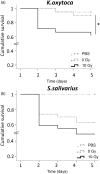Low-dose irradiation affects the functional behavior of oral microbiota in the context of mucositis
- PMID: 26202372
- PMCID: PMC4935431
- DOI: 10.1177/1535370215595467
Low-dose irradiation affects the functional behavior of oral microbiota in the context of mucositis
Abstract
The role of host-microbe interactions in the pathobiology of oral mucositis is still unclear; therefore, this study aimed to unravel the effect of irradiation on behavioral characteristics of oral microbial species in the context of mucositis. Using various experimental in vitro setups, the effects of irradiation on growth and biofilm formation of two Candida spp., Streptococcus salivarius and Klebsiella oxytoca in different culture conditions were evaluated. Irradiation did not affect growth of planktonic cells, but reduced the number of K. oxytoca cells in newly formed biofilms cultured in static conditions. Biofilm formation of K. oxytoca and Candida glabrata was affected by irradiation and depended on the culturing conditions. In the presence of mucins, these effects were lost, indicating the protective nature of mucins. Furthermore, the Galleria melonella model was used to study effects on microbial virulence. Irradiated K. oxytoca microbes were more virulent in G. melonella larvae compared to the nonirradiated ones. Our data indicate that low-dose irradiation can have an impact on functional characteristics of microbial species. Screening for pathogens like K. oxytoca in the context of mucosits could be useful to allow early detection and immediate intervention.
Keywords: Galleria melonella; Irradiation; biofilm; mucositis; oral microbiota; virulence.
© 2016 by the Society for Experimental Biology and Medicine.
Figures






Similar articles
-
The influence of oral Veillonella species on biofilms formed by Streptococcus species.Anaerobe. 2014 Aug;28:54-61. doi: 10.1016/j.anaerobe.2014.05.003. Epub 2014 May 23. Anaerobe. 2014. PMID: 24862495
-
Interaction of Klebsiella oxytoca and Burkholderia cepacia in dual-species batch cultures and biofilms as a function of growth rate and substrate concentration.Microb Ecol. 2005 Jan;49(1):114-25. doi: 10.1007/s00248-003-1066-z. Epub 2005 Jan 28. Microb Ecol. 2005. PMID: 15688257
-
Candida-streptococcal mucosal biofilms display distinct structural and virulence characteristics depending on growth conditions and hyphal morphotypes.Mol Oral Microbiol. 2015 Aug;30(4):307-22. doi: 10.1111/omi.12095. Epub 2015 Apr 20. Mol Oral Microbiol. 2015. PMID: 25754666 Free PMC article.
-
Microbiota and their role in the pathogenesis of oral mucositis.Oral Dis. 2015 Jan;21(1):17-30. doi: 10.1111/odi.12224. Epub 2014 Feb 25. Oral Dis. 2015. PMID: 24456144 Review.
-
Candida-streptococcal interactions in biofilm-associated oral diseases.PLoS Pathog. 2018 Dec 13;14(12):e1007342. doi: 10.1371/journal.ppat.1007342. eCollection 2018 Dec. PLoS Pathog. 2018. PMID: 30543717 Free PMC article. Review. No abstract available.
Cited by
-
Synonymous point mutation of gtfB gene caused by therapeutic X-rays exposure reduced the biofilm formation and cariogenic abilities of Streptococcus mutans.Cell Biosci. 2021 May 17;11(1):91. doi: 10.1186/s13578-021-00608-2. Cell Biosci. 2021. PMID: 34001238 Free PMC article.
-
Human gene and microbial analyses in rectal cancer complete responses to radiotherapy.BJS Open. 2023 May 5;7(3):zrad035. doi: 10.1093/bjsopen/zrad035. BJS Open. 2023. PMID: 37161675 Free PMC article.
-
[Research Progress on the Protective Effect of Intestinal Flora on Radiation-induced Lung Injury in Thoracic Tumors].Zhongguo Fei Ai Za Zhi. 2023 Jun 20;26(6):467-472. doi: 10.3779/j.issn.1009-3419.2023.106.11. Zhongguo Fei Ai Za Zhi. 2023. PMID: 37488084 Free PMC article. Chinese.
-
Correlation between gut microbiota characteristics and non-small cell lung cancer based on macrogenomics sequencing.Hereditas. 2024 Aug 27;161(1):26. doi: 10.1186/s41065-024-00328-w. Hereditas. 2024. PMID: 39192352 Free PMC article.
-
Probiotics in the management of radiation-induced oral mucositis.Front Cell Infect Microbiol. 2024 Sep 18;14:1477143. doi: 10.3389/fcimb.2024.1477143. eCollection 2024. Front Cell Infect Microbiol. 2024. PMID: 39359935 Free PMC article. Review.
References
-
- Sonis ST. New thoughts on the initiation of mucositis. Oral Dis 2010; 16: 597–600. - PubMed
-
- Sonis ST. Mucositis: the impact, biology and therapeutic opportunities of oral mucositis. Oral Oncol 2009; 45: 1015–20. - PubMed
-
- Sonis ST. The pathobiology of mucositis. Nat Rev Cancer 2004; 4: 277–84. - PubMed
-
- Vanhoecke B, De Ryck T, Stringer A, Van de Wiele T, Keefe D. Microbiota and their role in the pathogenesis of oral mucositis. Oral Dis 2015; 21: 17–30. - PubMed
Publication types
MeSH terms
LinkOut - more resources
Full Text Sources
Other Literature Sources
Molecular Biology Databases
Miscellaneous

